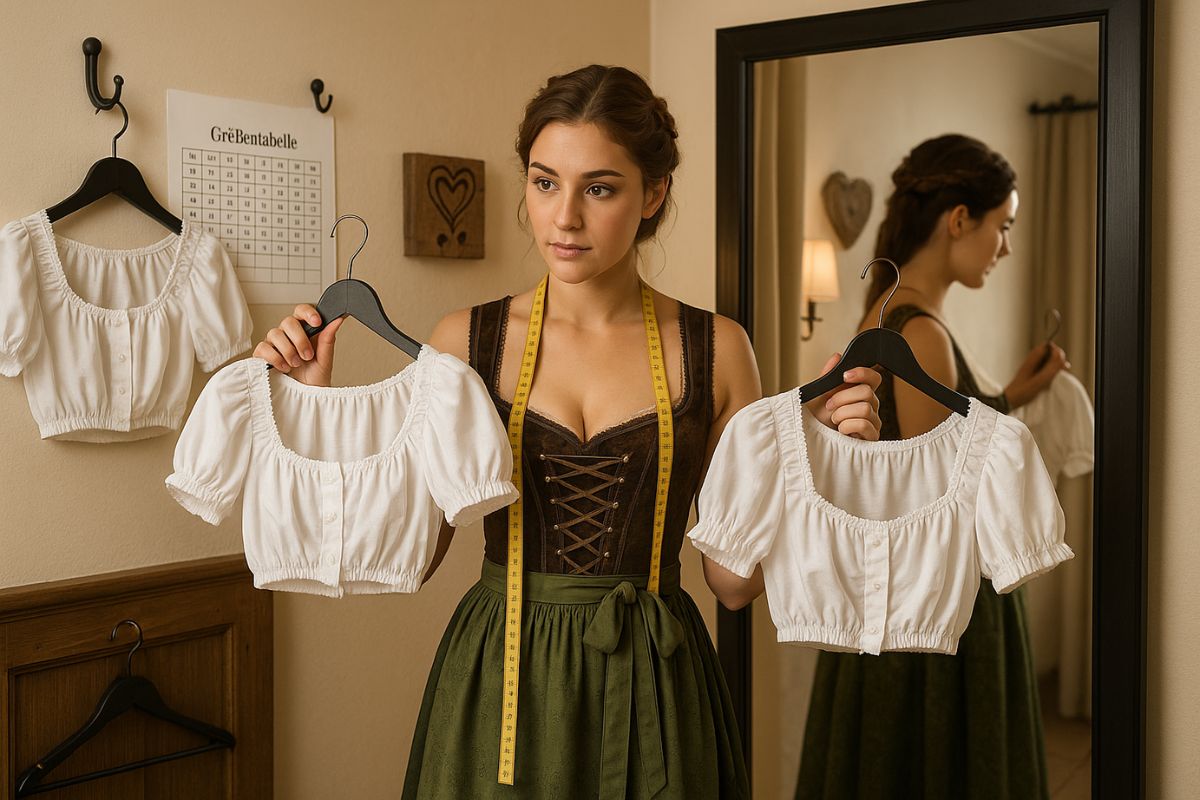
Blog
What Dirndl Blouse Size Should I Buy? Fit Guide Inside

What Dirndl Blouse Size Should I Buy?
When shopping for a dirndl blouse, one of the first things to understand is that sizing can vary depending on whether you’re using EU or US standards. European dirndl sizes are typically based on bust and underbust measurements in centimeters, while US sizes may seem more general but often don’t offer the same tailored fit. For example, a size 36 in Europe might translate to a size 6 in the US, but the shape and cut can still differ significantly. That’s why focusing solely on your usual dress size isn’t enough. Rather than relying on general dress sizes, it’s better to measure specific areas like the chest and ribcage, which directly influence how the blouse contours beneath the dirndl. This precision becomes especially important with traditional dirndl designs that emphasize structure and elegance.
How to Measure Yourself Correctly
To ensure your dirndl blouse fits flawlessly, taking accurate body measurements is essential. Start with the bust measurement by wrapping a soft measuring tape around the fullest part of your chest while wearing a non-padded bra. Make sure the tape is level and snug but not tight. Next, measure your underbust, which is the area directly beneath your bust—this determines how the blouse supports your chest and aligns with the bodice of your dirndl.

For shoulder width, measure from one shoulder seam to the other, across the back. This helps in choosing a blouse that won’t restrict your arms or gape at the neckline. Finally, check your sleeve length by measuring from the top of your shoulder down to where you want the sleeve to end—this is particularly useful for long-sleeved dirndl blouses or those with decorative cuffs. Taking these four measurements with care will dramatically improve the chances of finding a blouse that not only fits well but also enhances your posture and comfort. Keep your measurements on hand while browsing sites like German Attire, where accuracy ensures a perfect fit.
Dirndl Blouse Size Chart Explained
Choosing the right dirndl blouse starts with knowing how to read a size chart properly. At German Attire, our size chart bridges both US and German sizing systems while focusing on two key measurements: blouse length and chest width in inches. Here’s our standard size guide:
| Size | US Sizes | DE Sizes | Length (inches) | Chest (inches) |
| S | 2–4 | 32–34 | 12 | 17 |
| M | 6–8 | 36–38 | 12.5 | 18 |
| L | 10–12 | 40–42 | 13 | 19 |
| XL | 14–16 | 44–46 | 13.5 | 20 |
| 2XL | 18–20 | 48–50 | 14 | 21 |
| 3XL | 22–24 | 52–54 | 14.5 | 22 |
To use this chart effectively, compare your own bust measurement (taken around the fullest part of your chest) with the “Chest” column. For example, if your bust is 38 inches, the Medium (M) blouse with an 18-inch chest width may offer the best balanced fit, considering seam allowances and fabric stretch.

Keep in mind: if you’re between sizes, think about how you want the blouse to feel—snug for a classic Bavarian silhouette or slightly loose for extra comfort. Always double-check the blouse length too, especially if you’re tall or have a long torso, as it affects how well the blouse aligns with your dirndl bodice.
Fit Styles: Snug, Stretch, or Relaxed?
Dirndl blouse fit plays a crucial role in shaping your silhouette and comfort. From traditional snug fits to modern stretch fabrics, choosing the right style is about balancing aesthetics, movement, and confidence. Knowing how each fit style behaves—and how necklines or sleeves influence the look—will guide you toward the best choice for your body and your dirndl dress.
Traditional Snug-Fit Blouses for Authentic Form
Classic Bavarian dirndl blouses are designed to fit snugly, especially around the bust and shoulders. These styles emphasize a structured, lifted shape and pair beautifully with deeply cut dirndl bodices. However, they offer little flexibility, so correct sizing is essential to prevent discomfort or pinching. If authenticity is a priority, this fit may be your go-to—just ensure your measurements are precise.
Stretch Fit Blouses for Modern Comfort
Today’s modern dirndl blouses often feature stretch panels or full elastic fabric, giving wearers greater mobility without compromising style. These are especially popular among festivalgoers who plan on wearing their dirndl all day. The stretch accommodates slight size fluctuations and allows for more forgiving sizing—ideal for those between two sizes or seeking breathable comfort.

Relaxed Fit Options for Casual Looks
Relaxed-fit blouses provide a looser silhouette, with extra room in the sleeves, bust, or torso. These are great for a laid-back appearance or for women who want less restriction around the chest. While they don’t create the dramatic uplift of tighter styles, they offer excellent airflow and modesty, making them a favorite for warmer months or conservative dirndl cuts.
How Necklines and Sleeves Affect Fit
A dirndl blouse’s neckline and sleeve design can subtly change how the entire fit feels. Square necklines provide structure, scoop necks feel more open, and puffed sleeves can add volume around the shoulders. Always consider how these features complement your body shape and personal style when choosing your fit style.
Choosing Based on Bust Shape and Support Needs
Finding the right dirndl blouse isn’t just about size—it’s also about support and shape. The design and structure of your blouse should align with your natural bust shape and comfort preferences to create a flattering, secure fit. Whether you’re looking for lift, softness, or structure, understanding your body’s needs can help you choose between padded, underwired, or elastic-based options.
Padded Blouses for Enhanced Volume and Shape
If you prefer a fuller look or have a smaller bust, padded dirndl blouses are ideal. They add volume and give the appearance of a more pronounced cleavage, which is often desired in traditional dirndl styling. Many padded blouses also come with lightly molded cups that create a lifted silhouette, especially effective under plunging necklines.
Underwire Blouses for Structured Support
For women with a fuller bust or those who seek strong support throughout the day, underwire dirndl blouses offer excellent stability. These blouses mimic the fit of a supportive bra, lifting the bust and keeping it securely in place. They’re perfect for long events like Oktoberfest, where you’ll be moving, dancing, and celebrating without wanting to constantly adjust your outfit.

Soft Cup and Elastic Designs for Natural Comfort
If comfort and flexibility are your top priorities, soft cup or elastic-band blouses are worth considering. These styles gently follow your natural shape without heavy padding or rigid structure. While they may not produce the same push-up effect as underwire options, they’re breathable and versatile, especially for those with sensitive skin or minimal support needs.
Match Your Support to Your Dress Style
The amount of bust support you need can also depend on the style of your dirndl. A low-cut dirndl bodice pairs well with a structured, lifting blouse, while a high-neck dirndl may accommodate a simpler design with less lift. Ultimately, choosing the right dirndl blouse support ensures that your outfit flatters your figure while keeping you confident and comfortable all day long.
Fabric and Closure Impact on Fit
The materials and closure styles used in dirndl blouses can significantly affect how a blouse fits, feels, and adjusts to your body. From breathable cotton to delicate lace and stretchable blends, each fabric behaves differently when worn—especially under the structured pressure of a dirndl bodice. Similarly, closure styles like buttons, zippers, or elastic bands change how forgiving or fitted your blouse feels throughout the day.
Fabric Types: Cotton, Lace, Polyester, and Blends
Cotton dirndl blouses are a timeless favorite thanks to their breathability and crisp structure. They provide a snug yet stable fit, though they don’t stretch, so accurate sizing is key. Lace blouses tend to be more delicate and semi-transparent, adding elegance but often requiring layering or more careful handling. Synthetic blends like polyester offer stretch and durability, making them ideal for travel or long-day wear—especially when paired with modern dirndl styles.

How Closures Influence Flexibility and Sizing
Blouses with button closures offer moderate adjustability—you can leave the top button undone for a relaxed neckline or fasten fully for structure. However, buttons may gap if the blouse is too tight across the chest. Zipper closures, especially side zips, offer a sleek, fitted look but require precise sizing, as they don’t allow for much give. Elasticated closures or full-stretch bodices provide the most flexibility, comfortably adjusting to body curves and minor size variations, making them popular for modern and plus-size styles.
Choose Fabrics and Closures Based on Your Needs
When selecting a blouse, always match the fabric and closure style to your personal needs. Do you want breathable support for summer wear? Go for cotton with buttons. Do you need something that adapts to your movement and size changes? Opt for elastic or polyester with a hidden zipper. Being mindful of these construction details ensures you get a flattering and functional fit that lasts.
Avoiding Common Sizing Mistakes
Choosing the wrong dirndl blouse size can lead to discomfort, poor fit, or returns. Here are common mistakes to avoid when selecting your perfect fit:

- Prioritizing cleavage over comfort: Many buyers intentionally choose a size too small for added lift, but this often leads to restricted movement, gaping buttons, or fabric strain. A properly fitted blouse can still enhance your figure while keeping you comfortable and confident.
- Ignoring material composition: Different fabrics behave differently when worn and washed. Stretchy blends may allow flexibility, but rigid cotton requires precise measurements. Always check the fabric details to understand how your blouse will perform.
- Assuming your usual size applies: Dirndl blouses follow European sizing standards and can vary by brand. What fits in your everyday wardrobe might not translate directly—always refer to a specific store’s size chart, especially for bust and underbust dimensions.
- Overlooking brand-specific measurements: Not all dirndl brands size the same. Some have shorter cuts or smaller chest widths, so always consult the brand’s official chart rather than assuming a size M fits universally.
- Forgetting about sleeve and shoulder fit: Many buyers focus only on bust size, neglecting shoulder width or sleeve length. Ill-fitting sleeves can pinch, ride up, or look disproportionate with your dirndl—be sure to measure these areas too.
- Skipping return and exchange policies: Buying without checking the store’s return terms can lead to frustration if the fit is off. Choose trusted retailers like German Attire who offer clear policies and support for sizing concerns.
- Not checking customer reviews or photos: Real customer feedback often reveals whether a blouse runs large, small, or true to size. Images can also help you assess fit on different body types, giving you more confidence in your purchase.

Anna Bauer is a seasoned Bavarian fashion expert, cultural consultant, and heritage stylist with over a decade of hands-on experience in traditional German clothing. Born in Munich, the heart of Bavaria, Anna grew up surrounded by the rich traditions of Trachten fashion. Her passion for cultural attire led her to pursue a degree in Fashion and Textile Design at the prestigious University of the Arts Berlin, where she specialized in European folkwear.
Over the past 12+ years, Anna has collaborated with renowned Trachten designers, styled outfits for Oktoberfest events across Germany, and contributed articles to top fashion and culture magazines across Europe. Her work focuses on preserving the authenticity of Lederhosen and Dirndl wear while helping modern audiences style them with confidence and flair.
As the lead content contributor for German Attire, Anna combines her academic background, professional styling experience, and deep cultural roots to provide readers with valuable insights into traditional German fashion. Her blog posts cover everything from historical origins and styling guides to care tips and festival outfit planning—making her a trusted voice for anyone looking to embrace Bavarian heritage in a stylish, modern way.
